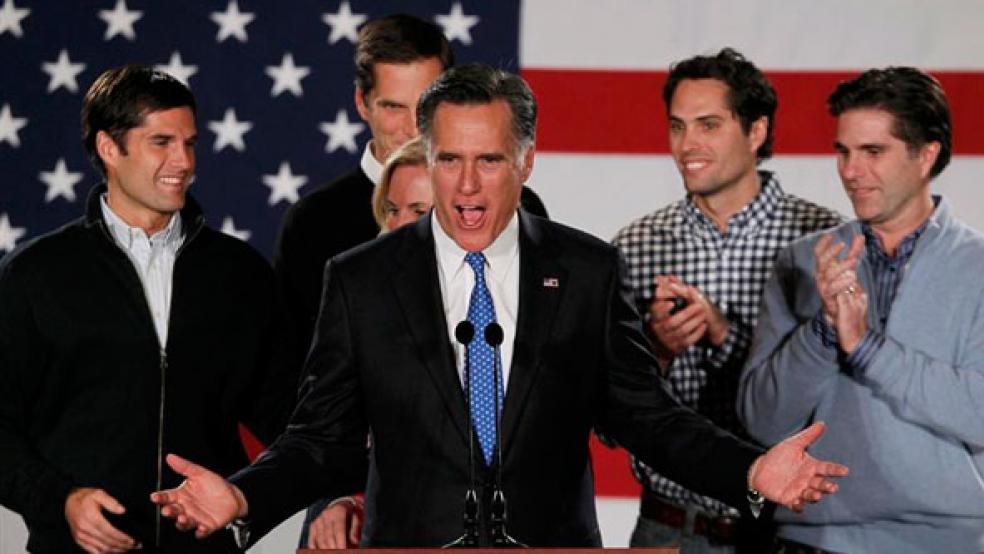Voters in Iowa might have intended to provide answers to Republicans nationwide with the non-binding Iowa caucuses Tuesday night. Instead, the squeaker between Mitt Romney and Rick Santorum, as well as the poor finish of Rick Perry, produced more questions than answers at the start of the primary season -- questions that probably won’t get answered in New Hampshire next week.
Can Mitt Romney, the narrow winner of the Iowa caucuses, break through the polling ceiling that has kept him at the same 25 percent support nationally as he won in Iowa, and conversely, can a Republican keep him from winning the nomination even if he can’t? And will Ron Paul’s campaign help or hurt Romney in the long run?
Throughout the primaries, Romney has enjoyed either a lead or second place in national polling – and in most states as well – for months. However, Romney’s support in these surveys has rarely bounced above a quarter of the respondents, with the notable exception of New Hampshire, where the first binding primary will take place next Tuesday. So far, Romney has been helped by a wide and active Republican field that has mostly stayed in the race, with Herman Cain and Tim Pawlenty the only notable exits in 2011. In a field of seven significant candidates, a consistent 25 percent level of support could win the nomination, although it would take longer than most Republicans would like.
Romney has also been helped by the curious boomlet phenomenon. Each of the remaining candidates has had a burst of popularity that threatened to eclipse Romney’s standing in the race. Each, however, descended almost as quickly as another boomlet candidate arose. Former Senator Rick Santorum managed to time his moment almost perfectly and lost by only eight votes on Tuesday night, a triumph of shoestring campaigning in a state known for rewarding retail politicking. That, however, leaves one of the weakest candidates in organizational and funding terms as Romney’s principal conservative opposition, and the number of conservative candidates in the race means that the opposition vote will be split in upcoming races.
Romney can’t count on a wide field for long, though. Michele Bachmann pulled out of the race after a sixth-place finish in her native state. Bachmann had been the first of the boomlet candidates, but lost supporters over time and had minimal impact in New Hampshire and South Carolina. However, those voters will likely go to someone other than Romney. If Rick Perry also withdraws, conservative consolidation could threaten Romney’s position within the primaries if he can’t find a way to break through the 25 percent ceiling.
This is not a new problem for Romney. As the Weekly Standard’s Jay Cost pointed out yesterday, the parallels between Romney’s performance this week in Iowa and his performance in 2008 are striking – and worrying for Romney supporters. Instead of winning Iowa by broadening his appeal, Romney’s opposition fractured more in 2012 than they did in 2008, when Mike Huckabee won the caucuses. Romney only showed significant improvement among those self-identifying as “somewhat conservative” and older than 45. Romney lost nine points among “very conservative” caucus-goers and five points among those making less than $50,000 a year. This suggests that Romney has not improved himself significantly in the Republican community despite having four years to build his new campaign.
A strong opponent would be able to take advantage of that. However, Romney has been lucky, as all of his competitors have proven significantly flawed. Rick Perry had the best record and resume and should have blitzed the field, along with Romney, by early October. A series of debate flubs and botched attacks derailed Perry into a fifth-place finish in Iowa on Tuesday. Santorum might prove more durable, but he has the same problem Huckabee had – a lack of fundraising capability and more heart than ground game. The latter can be acquired, but only if conservatives see Santorum as the only option remaining to a Romney nomination.
Romney also might benefit from Ron Paul’s outsider campaign, although that is a dangerous wild card for the GOP. Paul has returned from a marginal but tenacious performance in 2008 with a stronger, more experienced campaign. For a couple of weeks, it appeared that Paul might have had a shot at winning the Iowa caucuses, but in the end fell into third place, a few thousand votes behind Santorum.
Paul hasn’t come close to Romney in New Hampshire polling, and South Carolina’s first-in-the-South primary will likely limit Paul to a lower-tier finish. Paul won’t quit until the convention, though, just as in 2008, and his continued presence in open primaries and caucuses will take libertarian-minded votes from the mix. The question will be which candidate suffers most from losing those voters, and it probably won’t be Romney.
Paul also presents a threat to the GOP as a potential third-party candidate, an option that Paul has dismissed but with enough wiggle room to change his mind later. Clearly, Romney and his super-PAC allies have kept this in mind. Gingrich, Santorum, and Jon Huntsman have attacked Paul over his foreign policy positions and his past record, including his controversial newsletters. Despite the big polling numbers Paul attracted in mid-to-late December, Romney and his allies refrained from following suit with attacks on Paul. Instead, they focused on Barack Obama and Gingrich.
Romney is unlikely to woo Paul voters to his campaign, but Romney doesn’t want to push Paul and his bloc out of the GOP, with or without an independent bid. Keeping Paul in the primaries might give Romney a couple of close calls – perhaps most in Nevada’s binding caucuses next month – but will likely serve to keep some of the conservative-libertarian votes from coalescing around a consolidated conservative opponent, if one arises in time. If Romney wins the nomination without attacking Paul and his base, the friendly competition could convince Paul to stay within the GOP tent later, if for no other reason than to protect the bright future in the party of his son, Senator Rand Paul of Kentucky.
Consolidation will happen eventually, of course, through the brute force of attrition as campaigns fail. Will it happen quickly enough to put Romney at a disadvantage? Romney has a solid polling lead in the 40s in New Hampshire, and should sail through that test unscathed, making him the first non-incumbent Republican to win both Iowa and New Hampshire in decades. Newt Gingrich leads in South Carolina polling, but the latest numbers are from three weeks ago, before his fall to fourth place in Iowa. If Perry, Gingrich, and Santorum split the conservative vote in South Carolina, Romney could find victory in the 25 percent range – and then make an appeal to Florida voters for the intervening ten days to end the nomination race in January and focus money and effort on beating Barack Obama instead.
Gingrich understands this game plan. Yesterday, he told conservative talk-show host Laura Ingraham that he would team up with Santorum to defeat Romney, if Santorum wanted to build a no-Mitt alliance. It’s unclear whether Gingrich sees himself or Santorum as the lead candidate in that alliance, but given Gingrich’s legendary ambition, Santorum can reasonably assume that the lead candidate won’t be named Rick. Between the two of them, though, they will still be at an organizational disadvantage to Romney and Paul, both of whom have spent the last five years pursuing this opportunity.
A three-way race will make it tough for Romney to win with a 25 percent ceiling. Having four or five candidates changes that calculation, even if its’ just for the next few weeks. If conservatives don’t find a way to consolidate behind a single candidate, Romney may not need to transcend that ceiling to build enough momentum to win the nomination early.






